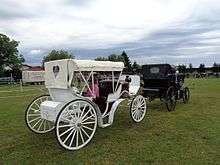Barouche

A barouche was a type of horse-drawn carriage fashionable in the 19th century. It was used mainly for travel in the summer, though it had a retractable cover for some protection from the weather. The barouche was based on an earlier style of carriage, the calash.
Etymology
The word barouche is an anglicisation of the German word barutsche, via the Italian baroccio or biroccio and ultimately from the Latin birotus, "two-wheeled". The name thus became a misnomer, as the later form of the carriage had four wheels.
Description and variations of the barouche
.png)


The barouche, used in the 19th century, was a four-wheeled, shallow vehicle with two double seats inside, arranged vis-à-vis, so that the sitters on the front seat faced those on the back seat. It had a soft collapsible half-hood folding like a bellows over the back seat and a high outside box seat in front for the driver. The entire carriage was suspended on C springs and used leather straps to connect parts. It was drawn by a pair of high-quality horses and was used principally for leisure driving in the summer. A light barouche was a barouchet or barouchette. A barouche-sociable was described as a cross between a barouche and a victoria.
The barouche-landau is a form of carriage mentioned in Emma, published in 1816 by Jane Austen. It "combines the best features of a barouche and a landau".[1] The structure of the carriage is heavier than it looks, because of the lack of a rigid roof structure. An illustration of the expensive and more rarely seen vehicle, on account of the expense, is shown in a paper by Ed Ratcliffe, citing editor R. W. Chapman's collection of the works of Jane Austen, in the volume Minor Works, as noted in Ratcliffe's sources.[1]
Barouches can be seen in the 21st century, as replicas of the carriages of an earlier time, in many places around the world.
Calash
The barouche followed from an earlier carriage type, called a calash or calèche: this was also a light carriage with small wheels, inside seats for four passengers, a separate driver's seat and a folding top.[2] A folding calash top was a feature of two other types: the chaise, a two-wheeled carriage for one or two persons, a body hung on leather straps or thorough-braces, usually drawn by one horse; and a victoria, a low four-wheeled pleasure carriage for two with a raised seat in front for the driver.
In Quebec, Canada, calèche refers to a two-wheeled horse-drawn vehicle with or without a folding top and with a driver's seat on the splashboard.[3]
In the Philippines, the kalesa is a one-horse descendant of Spanish Colonial calashes, and is a common sight in older cities such as Manila and Vigan.
.png) A two-wheeled calash
A two-wheeled calash- A four-wheeled calash to be drawn by a pair (Podstreda Castle)
 A Philippine kalesa.
A Philippine kalesa.
See also
References
- 1 2 Ratcliffe, Ed (2012). "Transports of Delight: How Jane Austen's Characters Got Around". The Inkwell. Menlo Park, California: Jane Austen Society of North America. Retrieved 14 June 2015.
- ↑ Ganado, Albert (2005). "Bibliographical notes on Melitensia - 3". Journal of the Malta Historical Society. Melita Historica. 14 (2): 173-174, see also footnote 8. Archived from the original on 21 April 2014.
- ↑ Musée McCord Museum - Caleche, Dufferin Terrace, Quebec City, QC, about 1920. McCord Museum of Canadian History, Montreal, Quebec.
External links
| Look up barouche in Wiktionary, the free dictionary. |
| Wikimedia Commons has media related to Barouches. |
| Wikisource has the text of the 1911 Encyclopædia Britannica article Barouche. |
- B1499 Horse-drawn carriage, barouche, timber / metal / glass / leather / textile, made by Shanks and Co, London, England, used by John Brown Watt in Sydney before 1888 - Powerhouse Museum Collection. Search for barouche. Powerhouse Museum, Sydney, Australia.
- Barouche: Definition with Barouche Pictures and Photos. Lexicus.
- Freesound :: view sample :: CalecheDownAlley.wav, Institut Universitari de l'Audiovisual (Institute of Audiovisual Studies), Universitat Pompeu Fabra, Barcelona, Spain. Sound file.
- Watch The Calèche Driver at NFB.ca